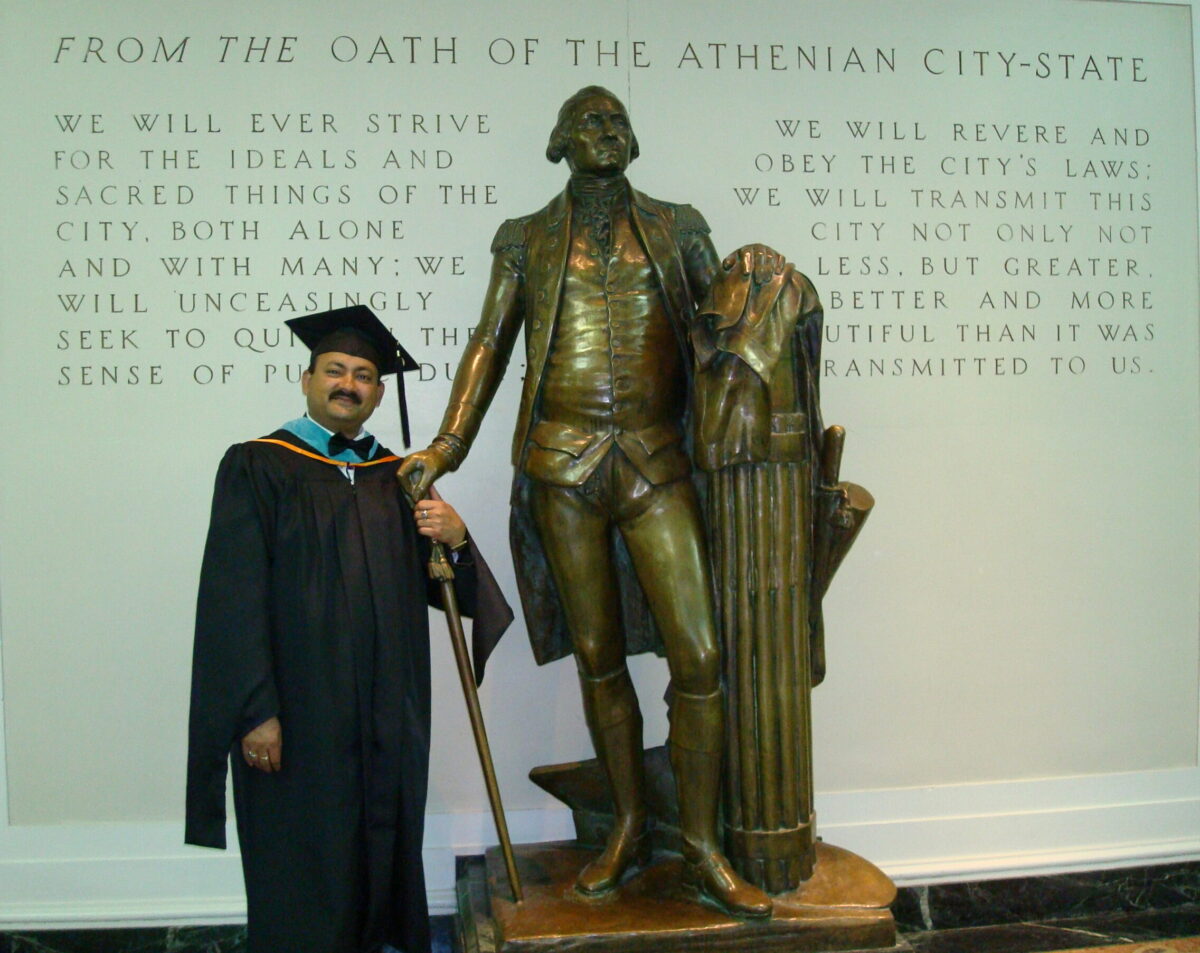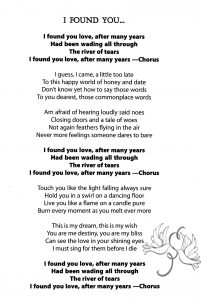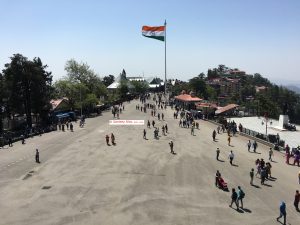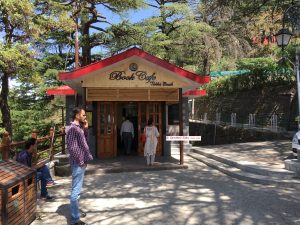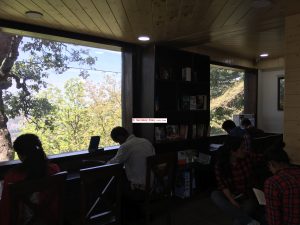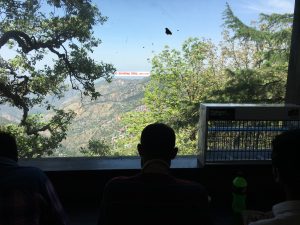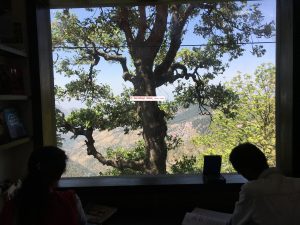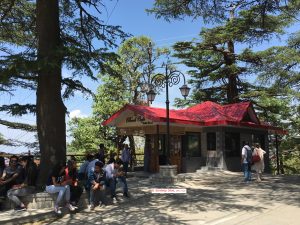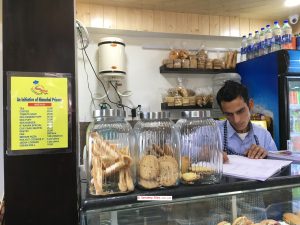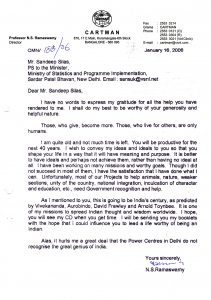Address of Sandeep Silas delivered in the distinguished presence of Hon’ble Union Home Minister, Government of India, Shri Rajnath Singh, at RIM event, Vigyan Bhavan, New Delhi on January 15th 2019 !
Tag: Ministry of Railways
Trailing the Faithline- Gangotri to Gaumukh by Sandeep Silas
Travellers must move on towards the destination, the source of life. There are always halts filled with magic en route, but the journey of the ‘seeker’ makes him plod on and on. While traveling to Gangotri I have taken a night halt at Bhairon Ghati, 9 kms short. Next morn, I leave the Bhairon temple in the care of its tree cluster, the GMVN Tourist Rest House happy in its hollow, and the rigid crags that tower above the place to their permanent positions. They have enacted the role of a protective godfather all through, as if shielding the hamlet from some danger. They have also successfully hidden the pleasures of the journey beyond as if they are a grave finality.
The thought of river Bhagirathi, like a mystical light shining in the distance, led me ahead till Gangotri was reached. Gangotri is a temple town, a holy place for most Indians. It is also the end of pilgrimage for some and the beginning of pilgrimage for others. The height above sea-level is 3140 m and you can feel the sharpness of the wind. Cars and jeeps line the thin metallic road and cops have a tough time organising orderly parking.
The religious significance of the place is immense. It is believed that river Bhagirathi owes its origin to the foot of Lord Vishnu, wherefrom it started flowing first, and was captured by the jatas (hair-locks) of Lord Shiva. That was a tale of heavens above. On earth, King Bhagirath, unable to bear the suffering of his people due to water scarcity worshipped Lord Shiva at Gangotri. His devotion so pleased Lord Shiva that he asked him for a boon. Bhagirath prayed that Ganga be released from Lord Shiva’s hair locks for the benefit of his people. So was granted Ganga to the earth. It is named after Bhagirath as river Bhagirathi from the point of its descent at Gaumukh up to Dev Prayag. At Dev Prayag, the river Alaknanda merges with Bhagirathi and thence onwards it is called Ganga.
An arched gate, gifted by the Border Police to the town, greets the eye. Everyone has to pass through it, the destination being Gangotri, temple, the bathing ghats or the steps leading to the trek route of 18 kilometers to Gaumukh. Gangotri temple is small. It is erected on the sacred stone where as per tradition Bhagirath worshipped Lord Shiva. The building is non-ornamental, rather ordinary in appearance. There are no statues on the exterior and its height is also about 12 feet. E.T. Atkinson wrote of it in the 19th century- “it is quite plain, coloured white with red mouldings, and surmounted with the usual melon-shaped ornament commonly known as Turk’s cap.” The temple is quite the same save that the colour combination is now white walls and silver top.
The serious trekkers take to the steps, which connect the Gangotri ghats and the trek route. Buy a walking stick— you might need three legs on the way ahead. The river Bhagirathi is a pleasant companion all through right up to Gaumukh. Sometimes the mountain rocks to your side echo the forceful holler of rushing waves. Yes the river makes them sing. The snow peaks enveloped forever in a clouded embrace of the Meghdoot (cloud messenger) sit happily above their unsteady glaciers. It is a treat to lift the eyes from a rivulet meeting the river bed; slowly caress first the green cover, then the black, rough and prominent crags; then allow the vision to melt in the snow at upper reaches.
The trekking route is tough, full of uneven stones, even dusty at times. It is a real test for the muscles of the legs. You really get to know more about your own legs than you believed. Tree trunks have been used to bridge rivulets and one has to balance steps lest the boulders in the water have the last laugh. The trek is a story of ascents and descents. You rise again as the path decides to lift itself from the riverbed. It is good to feel the heights. You tend to pause before every new face of a snow peak, which is revealed to you. The edges of the black crags are to be admired. The eyes can feel their razor thin sharpness and also their blunt prominence.
Shacks en route provide plastic comfort to weary travellers. They offer biscuits, potato chips, simple roti-dal (bread and pulses), paranthas (oil-fried bread), and bottled water. Mattresses to recline on are luxury! There are slogans displayed on banners about the ill effects of plastic and non-biodegradable waste. The glacial river must not be polluted with polythene or plastic wrappers. Thanks to these gentle reminders erected by environmentalists, the route is remarkably free of poly-pack litter. Travellers were seen actually heeding the advice and using dustbins.
Bite into something at Chirbasa, 9 kilometer deep, from the origin of the trek at Gangotri. Have some tea with a dash of salt, it will pep you up. The hamlet of Chirbasa is a cluster of pines rushing from the heights in a straight descent to the riverbed. Shacks are perched on space created between boulders on the ridge. This ridge you cross. Do not halt too long lest the legs refuse to lift again. Bhojbasa, 5 kilometres ahead, has to be reached for a night halt. And of course, sunset must be enjoyed at Bhojbasa before you hit the bed.
The flora along the trek route is different and interesting. Ganga Tulsi, a shrub with a heady scent, used as an accompaniment during Hindu worship, and White Jungle Rose, each flower with only four petals, almost line the route.
Yellow wildflowers too have a word to say! Some concerned environmentalist groups are trying level best to not only generate public awareness but also give a green cover to the Himalayas where it is most needed. So we see plantations of Spruce, Silver Fir, Blue Pine and Himalayan Cedar along the way. A little ahead of Chirbasa, some educationists nurse a Bhojpatra nursery. This effort at preserving a threatened specie is laudable. The Bhojpatra Utilis has a distinct white bark and round green leaves. Its botanical name is Betula Utilis. The bark of this tree served as paper for recording ancient Hindu religions texts. I peel some. It is actually as thin as finest quality paper. I keep it as a memento, but it is not enough to write a song!
There are no wild animals to sight save herds of mountain goat and deer. We see one. A goat blessed with a pair of curved horns is perhaps the leader of this herd and his posturing on a rock proudly proclaims it. The coat of the goats blends with the rocks. The black mountains have yellowish-brown traces. So does the goatskin. There are no trees on these hard infertile rocks and shrubs are sparse. How beautifully God has provided them protection by making them look like rocks! You are left wondering?
The sun plays hide and seek on a June afternoon. Clouds drift at will. Sometimes you see a snow mountain half-concealed by clouds and half-visible to the eyes. It is like watching a Venus, thinly clad, sensuous in demeanour, and amorous in the eye, whom you would like to only see and not touch!
The Bhagirathi river continues to sing its song as we continue upstream. It is past 4 p.m. in the evening. Our guide warns of falling stones in a patch ahead. A warning signboard and we smell trouble. True enough it rains stones on the route ahead. We do not carry hard hats. I hide behind a huge boulder clutching the hand of my 10-year old son. Stones keep rolling down. They can break bones or even throw a person deep down towards the riverbed by sheer impact. One has to exercise caution. This phenomenon in the evening is due to harsh winds blowing across. The mountains in this patch are loose stones embedded in mud. So the peculiar rain. It is strange coincidence that this is the 13th kilometer from Gangotri, I observe! We run across carefully finding our steps when the fury if the mountain is spent.
The last leg to trek for the day to Bhojbasa is tougher still. A stream has to be crossed sans a log bridge. You have to place your feet in the bed on firm stones so as to save your shoes from getting wet. My son exclaims aloud—“Tough route, tottering wooden bridges, falling stones, icy wind, quite deadly.” Still he makes the 14 km trek in good seven hours.
Alas my desire of watching the sunset at Bhojbasa is not fulfilled. The clouds just whisked away the sun in a swift move! I have to wait yet another day braving the biting wind on the Bhojbasa ridge. There is a GMVN Tourist Rest House, an Ashram and several shacks, which serve as night shelter. You come back in life to just hoping for basics; a toilet is a luxury.
The Bhojbasa valley is panoramic. It is really huge. Gaumukh is seen as a cluster of rocks from this ridge. It is the source of the river Bhagrathi or Ganga, regarded by Indians over the centuries as mystical, spiritual and holy. Three peaks of Mount Bhagirathi tower above Gaumukh. It is an unbelievable sight—one, which you deserve in a lifetime. The three summits, Bhagirathi I, II & III perhaps symbolise the trinity of beauty, truth and peace, which I presumed was exposed earlier to me on the trek. How wonderful!
The morning was proclaimed in a loud exclamation. The moon had not left its rightful reign of the night sky and the sun was raising expectations of travellers as it continued in its upward stride. Pure magic was being played all around Bhojbasa Valley by the Great God. Straight above Gaumukh, the cloud curtain was gradually being lifted from over the three Bhagirathi peaks. They were being revealed like sacred verses are spoken to listeners. If you lose them in that pure moment they are gone, sucked in by that force, which transforms the present into the past—the churning wheel of time.
Sure enough an overpowering cloud fall barred the snow peaks from sight in the next few minutes. So were gone two beautiful virginal peaks to our left, one, which was bravely trying to cradle the moon in its last sojourn! The sheer transience of the scene was mesmerising, just like elemental man-woman associations, which charm you as long as they last.
The last 4 kilometers to Gaumukh are tougher. Especially the very last! The trek reduces to nothing but trapeze walk over accumulated boulders. Only faith and will power can take you ahead. Finally Gaumukh, 4000 m above sea-level, is reached. I find a perch on a rock before the cave, the source, and settle down to my thoughts. As I look at Gaumukh, I feel the sensuousness and abundance of love. That love, which knows no bounds. That love, that gives and gives always and forever.
Gaumukh is a cave surrounded by glacial bottle-green ice. Water, the source and preserver of all life on earth, keeps gushing out in good measure. The spectacle is akin to a mother giving birth to a child. The half-moon cave is the source, the water life at birth. And you son of man, a part of this beautiful creation!
People bathe, pray here. By doing so they believe that they have purged all sins. I feel the icy water and look at the slab of ice bobbling beside the rock I sit upon. I look again at Gaumukh or the cow’s mouth, the name given to the glacier cavern. Next moment, I am in the water, my hands clutching a rock and my lungs holding my breath. I have done it! Yes how many get the opportunity to worship the mother source of a holy river at its hideout deep into the Himalayas. The sun is benevolent. It lights up eyes and many lives. The ice sparkles. Sometimes chunks of ice fall down from the top of the glacier cave to meet the water below. Huge blocks of ice and the current of water play a game with each other. The stream cuts into the blocks and pushes it mid-stream. The block tries hard to stay put on its temporary throne and breaks the current into two. The game continues here in a hitherto unusual unseen mirth of ice and water; both same and yet so different!
Above Gaumukh is Tapovan. All saffron clad barefoot or slipper-sporting sadhus (holy men) are headed for that territory. It is place across the Bhagirathi glacier where Rishis and Munis did penance and meditated. Today there is some alarming news from Tapovan. One traveller slipped and fell some distance below to hurt his head on a rock. He was evacuated on a makeshift stretcher by locals and some foreign trekkers. It will be almost ten hours before he reaches Gangotri, where first-aid is available. Bhojbasa, I think, demands a doctor, a medical unit and telephone connectivity for evacuation by helicopter in dire emergencies.
The Himalayan glaciers have long fascinated the British explorers who arduously mapped and recorded their uniqueness. Colonel Gordon (Roof of the World, 17) writes—“the glaciers of the Western Himalayas are twice as extensive as those of the Alps, and are probably the largest in the world or at all events larger than any others out of the polar regions.” How do you recognise a glacier and the river it has given birth, must be understood. I am tempted to quote Lieutenant R. Strachey on the appearance of a glacier—“It seems to be a vast rounded mass of rocks and ground utterly devoid of any sign of vegetation, standing up out of a grassy valley. From the foot of its nearer extremity the river, even here infordable, rushes in a turbid torrent out of a sort of cave; the top of which is but a few feet above the surface of the water. Behind this, the glacier rises less steeply like a bare gravel hill, to its full height, which is probably 500 feet above the water of the river when it leaves the cave.”
After a tete a tete with Bhagirathi glacier and river source one must return to Bhojbasa or if possible Chirbasa for a night halt. Walking early morn on return is pure satisfaction to the visual and olfactory senses. Start about 6–6.30 a.m. The clouds are still lazing in the valley. Their effortless glide up the mountains is inspiring. The atmosphere is filled with the fragrance of plants and shrubs, especially Ganga Tulsi. You become part of generous nature. Many prayers come to lips in such circumstance—God make me a mountain stream so that I can quench the thirst of earth, plants, and men; God make me a wildflower, so that I can enliven a jungle path; God make me a birdsong so that I fill the woods with music; God make me a cloud so that I roam anywhere at free will; God make me a mountain summit so that I tower above everything else; God make me the wind so that I can give life to the world; God make me a star in the sky so that I fill the eyes of your children with dreams. Any one of these prayers could be yours. The prayer of humility, of freedom, of power, or dreams; it just depends how you feel. I, for one, would like to end up as a birdsong in a forest!
All good things these days end up in a mix of concrete, machine and artificiality. Should you come here once, you would be happy that for some days you were only a child of benevolent Nature.
Twin Lives by Sandeep Silas
I Found You… by Sandeep Silas
Book Cafe, run by prisoners, at Shimla, India- a reform step; article by Sandeep Silas
In a country of 1.311 billion, 1401 prisons with 4,19,623 prisoners, divided into convicts and under-trials, only one officer has had the courage and sensitivity to recognize that prisoners too are fellow human beings.
True, some Court has sat in Judgment upon them for committing some crime or the other, but do we ever come to know of their real life stories, the actual circumstance, which compelled their impulse to do an act, which was adjudged as crime under a code of law. True, crime needs punishment and the latter is necessary to maintain a discipline in a civil society, but reform is also a possibility.
This opportunity has been realized by a distinguished Police officer posted in Shimla, (Himachal Pradesh) as Director-General (Prisons), Mr. Somesh Goyal, who incidentally is also a dear friend and a batchmate.
One officer Pankaj Raj conceived the idea of a Book Café, and Somesh Goyal executed it to be located at Takka Bench, just above the famous Ridge of Shimla, which is being run by prisoners, all serving a life sentence. Here, they serve pizzas, burgers, biscuits, tea, coffee and the usual stuff inside a Café, which has wall cabinets all around stuffed with books.
Montaigne says, “Ordinate conduct, moderation, constancy apart, I believe that anything at all can be done, even by a man who, taken overall, is lacking and deficient. That is why the wise men say that to judge a man properly we must principally look at his routine activities and surprise him in his everyday dress”.[1]
The atmosphere created is of a library café, where one can sit head down immersed deep in the world being unveiled by the book and occasionally look up through the windows far into valleys and beyond, into the realms of the mind…
The Book Café was inaugurated this April 11th by the Hon’ble Chief Minister of Himachal Pradesh, who also must be given credit for approving such a pioneering venture as a first in any State of India. The Café seats 40, and has free Wi-Fi. I liked the indoor décor of deodar wood, which gives a warm feeling in a hill city. A lot of books, available to a reader, narrate the history of the evolution of Shimla, which became the capital of the British Raj, with evocative photo prints. Apart from that you have historical philosophies, detective thrillers and travel & tourism books.
I saw many young couples and the recently married ones come to the café and for want of space inside sit in conversation upon the seating area around the majestic tree outside. Having completed my walk of 7.5 km for the day, I thought I could afford a pizza and had one. The courtesy with which I was served is worth mentioning.
Look into the faces and eyes of Yograj and Jai Chand and you will wonder why life made them captives of a criminal impulse and why their life is not like other men. Just for a second of indiscretion they got punished with a life sentence, live in jail as condemned persons, devoid of fresh air, freedom to go anywhere or to eat their heart’s desire. I don’t know the facilities inside the jails in Himachal, but from what I have seen they will be definitely sub-human. I do not have those X-ray eyes, which spiritual Masters possess, blessed with the ability to look deep into your soul, but, definitely I have a feeling heart and a thinking mind. So I don’t know for sure what thoughts a prisoner of fate like Yograj has as he serves the public here, but I saw he was thoughtful.
“I disclaim those incidental reformations based on pain. ‘God must touch our hearts’. I Samuel 10:26. Our conscience must emend itself by itself, by the strengthening of our reason not by the enfeebling of our appetites. [2]
I think that if other States of India could adopt this reformatory idea as ‘sharing of best practices’ a window of reform shall open quietly, inside hearts and our society.
Prison Statistics, India
|
Courtesy: World Prison Brief; http://www.prisonstudies.org/country/india
[1] Michel De Montaigne; The Complete Essays; On virtue; page 799; Penguin.
[2] Michel De Montaigne; The Complete Essays; On repenting; page 920; Penguin.
Ibadat-e-Aman 2017! Video 3
Ibadat-e-Aman 2017 held on March 18, 2017 at The Amphitheatre, India Habitat Centre, New Delhi
a peace bridge of music & poetry
Sandeep Silas ‘deep’ reciting his own Sufiyana shayari ! Video 3
Ibadat-e-Aman 2017! Video 2
Ibadat-e-Aman 2017 held on March 18, 2017 at The Amphitheatre, India Habitat Centre, New Delhi
a peace bridge of music & poetry
Sandeep Silas ‘deep’ reciting his own Sufiyana shayari ! Video 2
Ibadat-e-Aman 2017! Video 1
Ibadat-e-Aman 2017 held on March 18, 2017 at The Amphitheatre, India Habitat Centre, New Delhi
a peace bridge of music & poetry
Sandeep Silas ‘deep’ reciting his own Sufiyana shayari ! Video 1
Remembering #Prof. N. S. #Ramaswamy- his letter from my memorabilia
One day, Prof. N. S. Ramaswamy came to my office in Sardar Patel Bhavan and sat with me for over two hours. I remember a statement he made- “You are like a circus juggler, handling so many hats at the same time”! With humility I mumbled, “That is my expertise and training, Sir”! When he went back he wrote me a letter from Bangalore, which I chanced upon today in my memorabilia.
My personal homage to a great man, thinker, reformer, scientist, educationist and engineer! Above all a great human being!
N. S. Ramaswamy
| N. S. Ramaswamy | |
|---|---|
| Born | 2 March 1926 Puthur, Thrissur district, Kerala, India |
| Died | 17 September 2012 (aged 86) Bengaluru, Karnataka, India |
| Other names | Cartman Ramaswamy |
| Occupation | Management academic Social worker Educationist |
| Years active | 1952–2012 |
| Known for | IIM Bangalore Social service Institution building |
| Spouse(s) | Rajam Parvathi |
| Children | A son and a daughter |
| Parent(s) | N. R. Srinivasa Iyer |
| Awards | Padma Bhushan |
N. Srinivasa Iyer Ramaswamy (1926–2012), popularly known as Cartman Ramaswamy, was an Indian engineer, educationist, management academic and writer, and the founder director of the Indian Institute of Management, Bangalore.[1] He was the founder of Centre for Action, Research and Technology for Man, Animal and Nature (CARTMAN), a non governmental organization working for region-relevant and appropriate technology transfer to rural areas[2] and Indian Heritage Academy, an organization involved in propagating Indian cultural traditions.[3] He was also the founder chairman of the Adarsh Vidya Kendra (AVK) Group of educational institutions.[4] The Government of India awarded him the third highest civilian honour of the Padma Bhushan, in 2006, for his contributions to society.[5]
(Source: Wikipedia)
Video uploaded by Prof. N. S. Ramaswamy
#REFORMING AND #REVITALIZING #INDIAN RAILWAYS’ by Sandeep Silas; strategy paper presented in 2014 to High Level Committee on Railway Restructuring chaired by Dr. Bibek Debroy
REFORMING AND REVITALIZING INDIAN RAILWAYS’
Sandeep Silas
Dated: June 9, 2014
Presented before the High Level Committee on Railway Restructuring chaired by Dr. Bibek Debroy
Executive Summary
Nowadays we do not need a framework, which acts as a fortification against the public aspirations, but on the contrary one that is responsive, sensitive and attached to the public needs. What we have today is a traditional and control oriented organization. What we need is a learning and efficiency oriented organization. We have to get Railways out of its captivity of “skilled incompetence”. We should be brave to try out a new world order—“The fact is that every company, has a business diamond. Re-engineering can be thought of as replacing a diamond that has lost its luster and brilliance with a new one”. (D Aprix, Roger; Communicating for Change).
In this short paper I bring some new ideas, which are required to be implemented to have the Railway’ back on rail! I shall give the bullet points here briefly as an overview and at-a-glance!
- Reframing the Organization— Star Model approach rather than the top-down management we have today
- Amalgamation of the 10 different services we have today to form one single senior management level service, to prevent the silo growth pattern and heavy departmentalisation, which is suffocating the organization and preventing it from getting the best
- Strategy Planning, HR Management and Independent Director-Generals for Safety, Public Relations, and Commercial Publicity
- One Nation, One Budget
- E-Governance initiatives and Accounting Reforms— today we do not know what is the cost of running “a” particular train service!
- Set-up a Tariff Regulation Authority and a professional Disaster Management team (stop sending relief by Accident Relief Trains which take hours to reach, instead fly relief team by choppers)
- Mapping of assets by GPS
- Develop International Class Railway Stations with lease of space to commercial/business organizations
- Business orientation in decision making
- Project Management to be done professionally
- Double Decker Shatabdi’s to be introduced to bridge demand supply gap and increase revenue
Bold decision making is required to govern effectively. I submit a short paper on the reforms Railway’ require to pull itself out of the quagmire it has slipped into. What I will place below are reforms— short-term and long-term (which need to be set into a process now to get the desired results).
1.0 REFRAMING THE ORGANIZATION
The Railway administrative structure is governed by the Act of 1905 through which the Railway Board was set up as the decision making body for the Railways. This suffers from a self-limiting factor of the full Board, being on board, for a proposal to become a decision. Very British! And may be correct for the past times, but now become a major obstacle for progress and development as Railway works with a heavy departmental bias. Each Department has a Member, those who do not, have their Department vested into a Member. Each Member guards his Department like his kingdom, and contests every proposal, unless it is supportive of departmental interest.
To understand an organization very simply let us see what an expert writes: “The structure is the total of the ways in which labor is divided and coordination achieved among those tasks”. (Mintzberg)
How we coordinate these tasks is our expertise!
The most limiting factor of the present system is the boundaries it places on the political executive to give a direction and move the system. You just cannot go past the Railway Board, should it decide to be unanimous and engage the Minister in a confrontation. Even if it doesn’t, it adopts the go-slow approach to make a mess. Now, this can be a safety mechanism in times like we have seen in the past with different Parties being in seat, but the safety mechanism went into the waste paper basket as individual Member’s were willing to oblige in return for a position above or, from ranks below, to be elevated as Member.
I am suggesting a legislative reform to bring the Railway’s in sync with the rest of the Union Government. The reform is, “Break The Board”! Replace it with the system like that in any other Ministry, a Principal Secretary, and individual Secretaries, reporting to the Minister.
Advantages, those flow, would be quick decision making, sense of urgency in follow-up, clean-up of departmental bias in decision making, more emphasis on implementation, and easier monitoring and evaluation by the Minister. Of course, the thrust towards decision making based on the ideology of the ruling Party and manifesto guidelines would improve Railway’ tremendously. The amalgamation of the Railway’ into the rest of the Government of India will be a big achievement as today it functions as a separate Government within Government, insulated from outside, unmindful of the demands of the time and concerns of the Prime Minister. We have had instances in the recent past when an ally of the ruling coalition did not follow the tradition of Parliamentary democracy but assumed to itself the role of an independent satrap.
The Railway Budget is a relic of the British times, when it was found necessary to adopt an approach of a separate Railway Budget. Now, the times have changed and in order to make Railway a buoyant part of the Indian economy, we have to adopt One India, One Budget policy!
Nowadays we do not need a framework, which acts as a fortification against the public aspirations, but on the contrary one that is responsive, sensitive and attached to the public needs. What we have today is a traditional and control oriented organization. What we need is a learning and efficiency oriented organization. We have to get Railways out of its captivity of “skilled incompetence”. We should be brave to try out a new world order,—“The fact is that every company, has a business diamond. Re-engineering can be thought of as replacing a diamond that has lost its luster and brilliance with a new one”. (D Aprix, Roger; Communicating for Change).That is what I propose as a new order world with my “Break the Board” scheme!
The Star Model, which follows, could be adopted rather than the top-down model approach of governance we have today:
 As a beginning a short Consultancy can be given to the Maxwell School of Citizenship and Public Affairs (#1 ranked in the US) to suggest ‘reframing of the organization’.
As a beginning a short Consultancy can be given to the Maxwell School of Citizenship and Public Affairs (#1 ranked in the US) to suggest ‘reframing of the organization’.
1.1 CHANGING HOW WE GOVERN RAILWAY’
At present the Railways is organized into 10 services of the Government of India! IRTS, IRAS, IRPS, RPF from the Civil Services Examination and IRSE, IRSS, IRSME, IRSSTE, IRSEE, from the Indian Engineering Services Examination, and the Railway Board is staffed by the RBSS, a secretariat service.
Each reports to its Member, who virtually is their King. The 60 positions of DRMs, 16 of Zonal GMs, 9 GMs of Production Units are distributed as per a quota system distributed amongst the many services. This has imposed rigidity upon the system and a mind-set of being in a department, belonging to a department and fighting for the survival of a department. Where is the organization and the organizational interest? Of course, that is a casualty of this present structure of the organization.
I suggest amalgamation of all services into one Indian Railway Service, after every civil servant has rendered minimum 12 years service in his/her parental department. This amalgamation should come about as a result of a qualifying performance review held by the UPSC and those who do not qualify should continue within the technical streams. Those who qualify should be placed on positions of DRMs and GMs and Members / Secretaries.
Some amount of merit based selection is necessary in the emerging times as India is passing through a very important phase in its development. If we do not recognize the currents, which are flowing towards us from all across the world we shall end up as the story of the frog that got baked in a glass, the one who was baked to death, because it did not pay heed to the rising temperature of the external environment. It missed to see the hot air currents coming from all around! It thought the rise in temperature was gradual and started rather enjoying the hot water, till the water boiled and baked the frog.
I place before you the web of inclusion, designed by Helgesen. In a system where inclusiveness is the guiding approach in policy, planning and implementation, this model deserves to be adopted in governance.
The biggest advantage of this above approach is that we shall convert the Railway into an organization that thinks and acts as one and harness all resources for development according to the needs expressed by the public not as governed by respective departments for survival and expansion of self-interest.
2.0 IMMEDIATE REFORMS AGENDA
The Railway Minister’s priorities could be:
2.1 Status Papers
- A Status Paper from each Member on the functioning of his department.
- A White Paper to be brought out in Parliament on Railway finances, which shall set the ball rolling for reframing the organization as suggested above.
- A Status Paper on the Projects in hand (Railway is one of the worst Ministries with large time and cost over-runs of projects). It often keeps projects alive on marginal funds to maintain establishment and is adept at shifting timelines five times over!
- Ask for a Business Plan from each Member of the Board indicating the results his/her department is going to produce in 1 month, 3 months, 6 months and 1 year!
2.2 Member Strategy Planning
Create a Member, Strategy Planning in the Railway Board who shall oversee all development of strategy. This should become the pre-cursor to having national activity thrust at the heart of Members, not departmental Members. “Strategic Planning is the heart of strategic change”. It is a “process by which the guiding members of an organization envision its future and develop the necessary procedures and operations to achieve that vision.” Pfeiffer, Goodstein, Nolan. So how can we have such a big Railway, without strategic planning?
2.3 HR Management
HR Management is a big question mark in the Railways. Again we see an ad hoc approach visible in handling the vast human resource. As a result officers (11,000) do not give their best to the system, and the staff (14 lakhs) have an unending list of grievances.
To begin with all service record, Discipline & Appeal cases, Pay Sheets, Career Profile should be fully computerized. Officers to be posted as careful thought of a well-rounded career rather than pure pick and choose approach that we see today. Actually, the ones who can gratify by other means are posted to lucrative positions ignoring merit and standing in the system. Professional acumen and specialization does not matter in the system today. We need to manage HR professionally.
Merit based selection should be introduced for Board Members, till the new system as proposed in my first point comes into effect by way of legislative reform.
Culture of subordination to be replaced by respect for work and expertise of an officer, not just hierarchy based behaviour. Actually, corporate culture should become the management culture.
2.4 E-Governance Initiatives
Set in pace E-Governance interventions immediately for transparency and reducing corruption. An E-Governance Team can be formed to suggest applications matching the requirements of the people of India, which the Railway transports. For example, Freight Booking by internet interface, D-Mat RRs, RRs to be made negotiable instruments, E-payment of parcel traffic, free sms alerts for those who book on-line with train running position updates.
Form an IT Solutions Team to report directly to the Chairman.
2.5 Accounting Reforms
Accounting Reforms- costing of all services should be done and all decision making to be business like. Today, if you ask the Railway Board Chairman what is the cost of introducing a new train service and the recurring cost to run the service daily, you will draw a blank!
2.6 Developing International Class Railway Stations
The Station Development Authority has been formed, which is a welcome step. It should be asked immediately to identify and go in a big way to make plans and develop major stations, T-3 Terminal style, to generate more revenue from commercial activities and providing to the public better stations of international standards.
2.7 Standardization
Standardization of every identifiable service and product.
2.8 Tariff Regulatory Authority
Set up a Tariff Regulatory Authority rather than having a totally non-professional “Rates” department. Why can’t we have dynamic pricing of tickets as per the season?
2.9 Disaster Management
Creation of Disaster Management Units at different points in the country equipped with expertise, technology and air rescue support in times of major train accidents. We have the system of Accident Relief Trains in every Division, which means effectively handling a train disaster by the relief team coming in a train. This is often many hours away as every ART has a defined beat. Where in the world do we handle railway accidents like this? People cannot be left to die on the tracks just because we have a rudimentary way of handling emergencies, which require speed and attention within the golden hour.
3.0 GPS Mapping of Assets
Introduce GPS mapping of assets. This will produce a paper showing how unproductive many assets are! Whys should the system carry burdens unnecessarily?
3.1 Open Lateral Entry
Allow lateral entry at different levels from the other civil services especially finance, land amenities, and Rates, as encadrement of posts promotes mediocrity and denies the organization its right to benefit from specialization. Vice versa encourage Railway officers to move more in other Ministries to gain from the experience of serving in other Ministries. At present Railway’ is very insulated and continues in its drift of a slow stream.
3.2 Formation of independent Director-General office for Safety, and similarly for Information & Publicity, and Commercial Publicity
Safety of trains should become one of the priority factors in governance. Of late major accidents have happened killing innocent people even in slumber. Formation of a system of a Directorate under Director-General, Safety reporting only to the CEO is a must. Accordingly, the Safety officers down the line should take directions from this Directorate rather than the local General Managers. Place Addl. DGs in Zones.
Director-General, Information & Publicity to be created like above to deal with the subject of publicity professionally rather than the present ad hoc approach adopted by Chairman in Board and General Managers in Zones, who are only interested in their photograph appearing in the media rather than placing the organization ahead of themselves.
Director-General, Commercial Publicity to be created to find out more opportunities and generate additional revenue. It cannot continue to be an activity of the established routine red tape, but has to be a function, sensitively and imaginatively handled. Railways own prime land at prime locations and this is lying waste or encroached. Should there be a Directorate to oversee and enter into Public Private Partnership models with full authority Railway’ can generate revenue equal to what it generates from sale of tickets.
3.3 Business Orientation in Decision Making
Business orientation in decision making to be adopted. Today all decision making is technology based. History is witness that organizations who follow this route take decisions for the sake of technology and not the people. The people’s interest should govern the technology to be adopted. It shall also have the added advantage of making the organization lean, and not fat with the burden of unwanted technology or technology desired for it brings benefits in purchase to pay its master.
3.4 Project Management
Separate classification of projects justified on social and strategic grounds for which the financing pattern should see flow of budgetary support from the Union Budget.
Project Teams should be in place for each and every project. At present the General Manager distributes the big projects to the CAO (Construction) under him and passes on the petty projects to the Divisions. It is not a professional approach and the Government loses a lot in cost over-runs, the people lose in time over-runs.
Development Radar concept should be adopted for better monitoring and evaluation of projects with financial and physical progress indicators.
Projects should have a fair regional distribution rather than be on the mercy of the chance of having a Minister from your State to hope for some railway project. In any case the development of the North-east deserves special mention by giving those states railway projects, which would help them come faster into the mainstream.
3.5 Outsource Peripheral Activities
Peripheral activities should be outsourced rather than the do-it-yourself approach. Today an activity like linen supply management is in-house with the Government spending tax payers money in building mechanised laundries! Why can’t it be given to the private sector to manage rather than involve huge expense of this management upon the finances and the much essential “time”? Officers who should rather concentrate on core activities of train operations are busy in linen management, that’s why safety activities become a casualty! Railway’ has to identify core activities, which it must do itself and peripheral activities, which should be passed on to the private sector.
3.6 Use of I-Pads for Ticket Checking
Introduce ticket checking with I-Pads linked to the charting base. All tickets to have a bar code and the I-Pads to have bar code readers. This shall be a people friendly decision and reduce heavy corruption on trains. Today, on TTE of a Rajdhani train takes home almost Rs. 20-25,000 per trip by way of selling berths illegally and surreptitiously!
3.7 Think Tank
Set up a Think Tank with advisory panel drawn from Universities and IITs. This can be a body for the Railways to advise and direct policy formation. The Railway’ is in the grip of a mind-set that policy is what we think the people want, not what the people actually want. In my paper above I have earlier brought out the fact that technology is dictating policy, not the public demand. Where are the stakeholders, those who are so vital to policy formation?
3.8 Annual Conferences
Annual Conference with State Governments, Ministries like Transport, and one technical international Conference to appreciate new useful technologies emerging internationally which can be adopted or customized.
3.9 Wagon Leasing
Introduce Wagon Leasing. Today Railway’ manufacture and own wagons. This activity can be passed on to the private sector, which has the capacity and financial prowess to do this.
4.0 Cash Less Transactions & Service Improvements
Promotion of cash-less transactions on physical sale points, which shall drastically reduce corruption. It is the petty everyday life corruption that bothers the general public as it affects a person directly. If we can evolve systems to reduce corruption faced by the common man in everyday life we would give the people immediate personal relief.
- Set up a Billing Department for Sundry earnings.
- Booking of Public Retiring Rooms on the internet.
- Escalators for the public at major railway stations.
- To stop the Rs. 30/- charged on every credit card transaction to the passenger by Railways.
4.1 Art of Analysing and Thinking
The whole problem of Railway’ is that today much of the the top executive have not developed the art of analysis and thought. They keep themselves immersed in taking “train running” position 24 X 7, the job they first learned as probationary officers attached to the Chief Controller in a Control Room. This is true of all departments as hierarchy subdues talent. Is this the CEO should be doing and expecting others to do? True, it is important, but cannot be allowed to occupy the total management time available. There has to be a system and process approach encouraged in the organization rather than the ‘dog under the engine’ approach (the dog started moving when it saw the engine move and then started thinking that he is making the engine move).
“What is the vision of Indian Railways?“No one has ever done the visioning exercise for IR till today. And so no one down the line is aware of any shared vision. How do we expect the 14 lakh employees to give their best to the organization? This is the fate of a huge and public need organization today.
4.2 Introduce new Double Decker Shatabdi trains
Last, but most important and visible decision should be to introduce a new genre of Double Decker Shatabdi trains. Proposal about increase of more trains would be met with a line capacity constraint, so I feel, if you cannot go horizontal, go vertical! These could be viewed as a gift to the people from Hon’ble Prime Minister who has shown the courage and determination to give good governance to the people. In our country one has to keep doing, keep doing, and keep doing, for the challenges are so immense and public demand insatiable. I think if the challenges are many, so are the opportunities!
In our country the most unfortunate thing is not to recognize talent till the west has appreciated it. A friend of mine with less experience, less skills, less maturity, much less contribution, who studied with me in Maxwell School of Citizenship and Public Affairs, NY, was placed on return as member in the National Security Council in Afghanistan, but here we are captive of imposed situations unless something dramatic happens to us for our skills to be used for much more advantage for the people than in the present circumstance.
I submit this Paper on Reforms required by the Railway’ for kind consideration, with humility and my personal respect for this great country.
© Sandeep Silas, Delhi, India
www.garlandofpeace.com
www.sandeepsilas.com
JAI HIND!
*********
